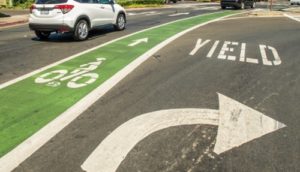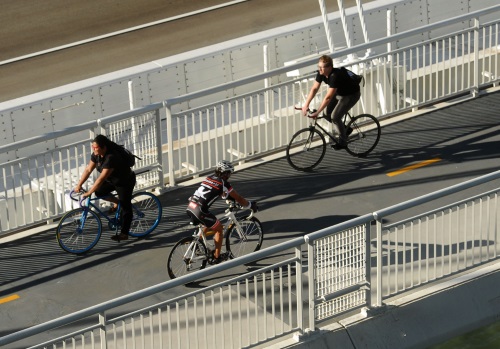The California Department of Transportation plan to invest an extra $100 million into active transportation projects aims to build more non-motorized links between neighboring communities that, for years, have been connected mainly by freeway exit ramps.
[Above photo courtesy of the Metropolitan Transportation Commission.]
Some of the funds will be used for stand-alone active transportation projects, while some will go toward introducing walking and biking infrastructure into existing highway projects. Caltrans noted it already has identified 22 projects that now will have additional walking and biking improvements.
The plans “represents a critical step in our effort to build and enhance a transportation system for all users and make our communities more livable and vibrant places,” explained Toks Omishakin, director of Caltrans, in a statement.
Dave Snyder, executive director of the California Bike Coalition (CBC), added that the story behind this “active transportation” investment effort by Caltrans is just as significant as the $100 million the agency is offering to facilitate more walking and biking activity.
Caltrans “already had their set of projects for the next two years approved, and they were ready to go with their package,” Snyder noted. “Then this new director comes in and says, ‘I think we can do better for bicycling and walking.’”
Chris Clark, Caltrans media relations manager, said Snyder’s account is “100 percent accurate. In truth, Toks wanted more than $100 million.”

Omishakin, who was appointed director of Caltrans in September 2019 and is widely recognized as an active transportation advocate, told his staff to “value engineer” $4.2 billion of transportation projects in order to get an extra $100 million for bicycling and walking.
“That’s a very significant step,” CBC’s Snyder said.
The exact project identification process will take place at the local level, with each of California’s 12 districts holding public engagement sessions to help develop the District Active Transportation Plans and guide which projects will be constructed.
“They have made a strong statement, and I am impressed,” Snyder added. “What I can’t say yet is that they’re significantly changing the culture in the mid-levels of the agency, where important decisions get made. They have to be willing to prioritize the convenience of walking and biking over the convenience of highways.”
Caltrans’ Clark said he understands Snyder’s reticence, but he stressed that Omishakin has made it very clear “that active transportation is a top priority for the department.”
Other state departments of transportation are also increasing their support for more bicycle and pedestrian options in a number of ways.
The North Dakota Department of Transportation, for one, issued more than $2 million worth of Transportation Alternatives or TA grants to help fund a variety of urban and rural active transportation improvement projects across the state in July.
And in July 2019, the Ohio Department of Transportation noted that ongoing trends in safety, demographics, and demand spurred it to develop its first-ever policy plan for walking and biking – a plan the agency hopes to craft with public input gleaned from a series of stakeholder meetings and online surveys.
A report issued by the Rails-to-Trails Conservancy in October 2019 highlighted that there is an overall monetary benefit from investing in projects that shifting short trips from driving to walking and biking via connected active-transportation infrastructure. The organization argued that funding such a “shift” could help generate a return on investment of $73 billion to $138 billion per year in the United States – if such active transportation infrastructure is connected to public transit systems.
However, the organization emphasized in a statement that shifting short car trips in both urban and rural areas to non-motorized ones “will take policy, behavior, and perception change, which can only occur if connected networks of safe and protected walking and bicycling facilities are built all across the nation.”

